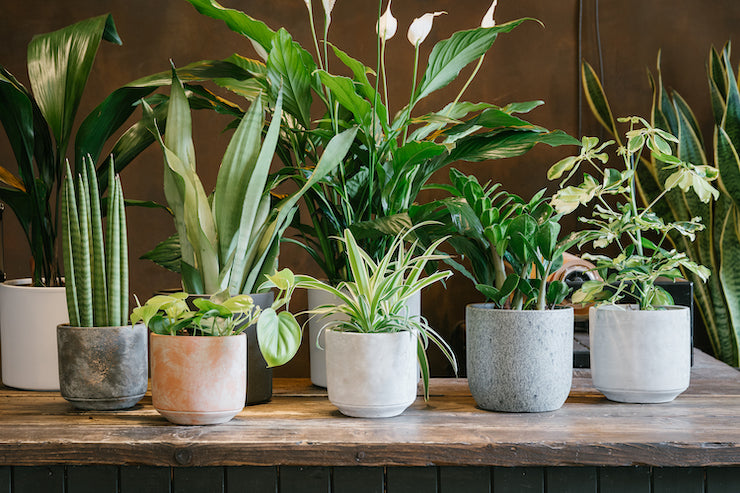
Common Plant Pests and How to Treat Them
Is there anything more painful than finding pests on your plant collection? Even with the best plant parenting it is difficult to prevent these wee beasties from finding our most prized potted friends.
Here is a rundown of some of the most common plant pests and how to treat them.
Thrip
There are around 150 different species of Thrip found in the UK which can affect both indoor and outdoor plants. These bugs can appear on the leaves of our houseplants at several stages of their life cycle. The adults can vary in their colouring from black/brown to yellow/brown, but are most identifiable by their narrow bodies that can be as long as 2mm. They have two pairs of thin wings fringed with tiny hairs. These wings are often folded back when the insect is at rest. Immature stages appear as tiny wingless insects that can range from creamy yellow in colour to a pale brown.
Thrip burrow into the leaves of houseplants and feed on the developing tissues found predominantly in the new growth and flowers. A clear sign that your houseplants have Thrips are leaves turning dull green in colour. Silver-white mottling can appear on the surface of the leaf and tiny black excrement can be found on affected areas. White flecking can appear on flower buds and can result in stunted future growth.
First isolate your infested plant away from your collection to prevent the further spread of thrip. Rinse the plant and then wash down the leaves with warm, soapy water. Finally spray the top and underside of the leaves, the stem and the top of the soil with SB Invigorator Spray. Repeat once a week until there are no signs of thrip on the plant. SB Invigorator is a superb spray that not only treats pests without the use of harsh chemicals, but also strengthens the plant. These insects are particularly difficult to get rid of and it is best to remove any severely infested leaves with clean, sharp scissors. If the pest problem persists predator bugs such as Amblyseius Cucumeris mites prey on thrip and are often a great form of pest control.
Spidermite
Did you know that Spidermite is a member of the arachnid family? Mature stages can be identified as tiny bugs with eight legs and can either be reddish or pale brown in colouring. Juvenile stages appear as tiny adults. These bugs make home in colonies on the undersides of our houseplant leaves. A single female can lay hundreds of eggs at a time allowing these bugs to quickly spread throughout the plant. This pest is usually less than 1mm in size so it is easier to look out for the damage they cause than the bug itself. Spidermite feed on leaf sap and faint dots can often be seen where the leaf has been pierced during feeding. As the sap continues to be eaten leaves yellow, dry out and then drop off. The infected plants new growth can also appear as limp and sickly.
Like all pests, Spidermites love to spread onto the closest healthy food source. They can do this by producing a fine webbing that can be easily dispersed on breezes or onto the clothing of passers-by to then hop across your houseplant collection. Therefore, it is important to isolate any infected plants into a separate room. To treat your plant, wash down the leaves and stems with warm, soapy water. Next, spray the leaves, stems and top of the soil with SB Invigorator Spray once a week. Repeat until you no longer notice any bugs or signs of new damage on your plant. Spidermite hibernate over winter and awaken in the warmer, dryer conditions of summer so up the humidity levels around your plants with more frequent misting to prevent them from reproducing.
If you notice any particularly large colonies or webbing on the leaves of your plant, we recommend pruning these back. This will make controlling the infestation and treating the pest much easier. Predatory bugs such as Phytoseiulus persimilis Mites can also be a highly effective treatment.
Mealeybug
Mealybug are another sap-sucking pest that is related to Scale. They are small bugs with recognisable shells formed of white-grey ridges. These shells resemble miniature, elongated slaters. Mealybug make home in the sheltered parts of our houseplants and can be found on the leaf axilis, the undersides of the leaves or beneath loose bark. Here they will produce clusters of protective white webbing where groups of bugs can be seen sheltering beneath. Mealey infestations can also be identified by a sticky substance that they secrete called ‘Honeydew’. This creates the perfect breeding ground for a black, sooty mould which can be seen on the surface of the leaves and stems.
Mealybug shells have a slightly waxy coating which makes it very difficult to kill these bugs, but with persistence and regular treatment it is possible to control Mealybug outbreaks! Begin by isolating the plant from your houseplant collection. Shower the plant with room temperature water, then wipe down the leaves with warm soapy water. It is worth using a cotton bud to remove any particular stubborn bugs from hard-to-reach crevices. Finally, spray down every part of the plant with SB Invigorator Spray once a week until the bugs have died off. Ladybugs can be introduced to your plant as they will happily munch on any Mealy they can find!
Scale
There are 25 different species of Scale in the UK and can range in size from 1mm to 1cm in length. Adult Scale are black in colouring but can appear a light beige earlier on in their life cycles. You may even notice clusters of wax-like bumps on the undersides of leaves. These waxy fibres protect their eggs.
‘Scales’ act as a protective barrier which makes it tough to control them with pest sprays so it is best to remove any heavily infested leaves. For the best results wipe the bugs off the plant with warm soapy water and apply SB Invigorator spray once a week. Repeat until there is no more evidence of scale.
Aphids
The UK is home to over 500 different species of Aphids and can be found on a whole host of plants indoors and outdoors. They are soft-bodied organisms whose colour can vary from green, black, orange, brown, pink and even brown. They are around 1mm to 7mm.
Aphids suck the sap from our plants which cause weakened plants and stunted growth. Some varieties also produce a sticky, honey dew substance that attracts mould. They live in colonies and reproduce so quickly that nymphs are born with new bugs already inside them. They develop so fast that they can reach adulthood in just 7 days. So you can imagine how difficult it is to control an outbreak.
To treat Aphids, isolate your plant. It is most effective to shower your plant with room temperature water and then wipe down the leaves and stems with warm soapy water. Natural predators such as Lady Bugs are also highly effective for controlling aphid populations.
Fungus Gnats
These tiny black flies that buzz around our houseplants are one of the most encountered pests. Look to our previous blog, ‘Fighting Fungus Gnats’ for more details on how to dissuade these menaces from buzzing around your urban jungle.
There are so many different remedies out there for treating household pests, but here are our tried and tested methods. Most importantly remember as nice as it would be, it’s often hard to get rid of plant bugs on the first treatment so stick at it!



